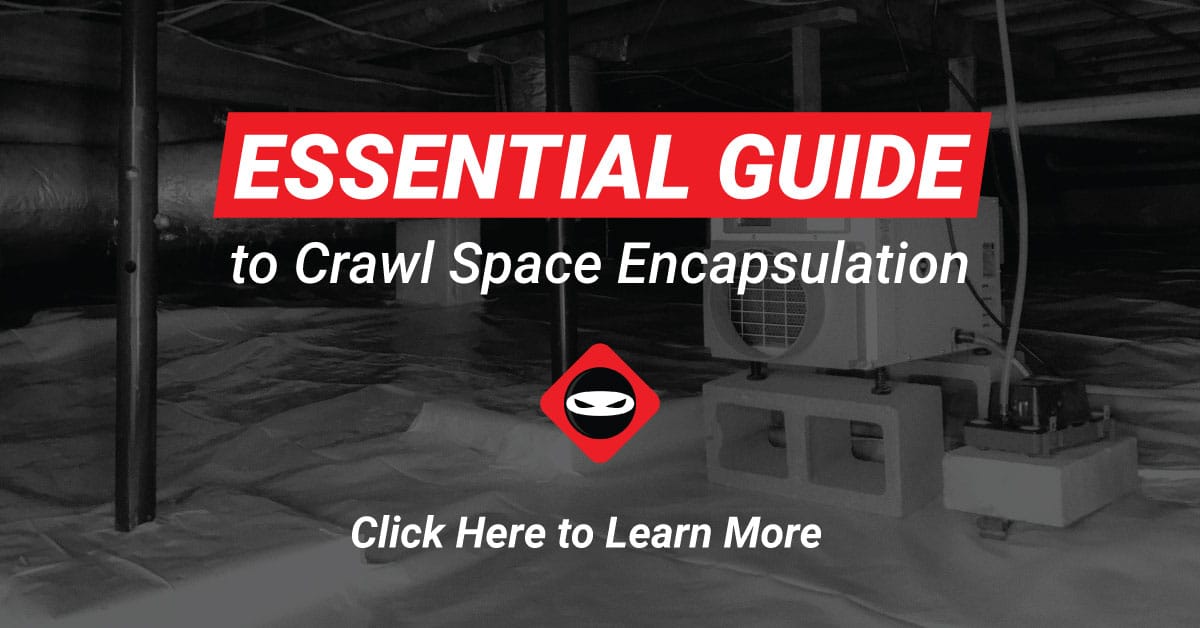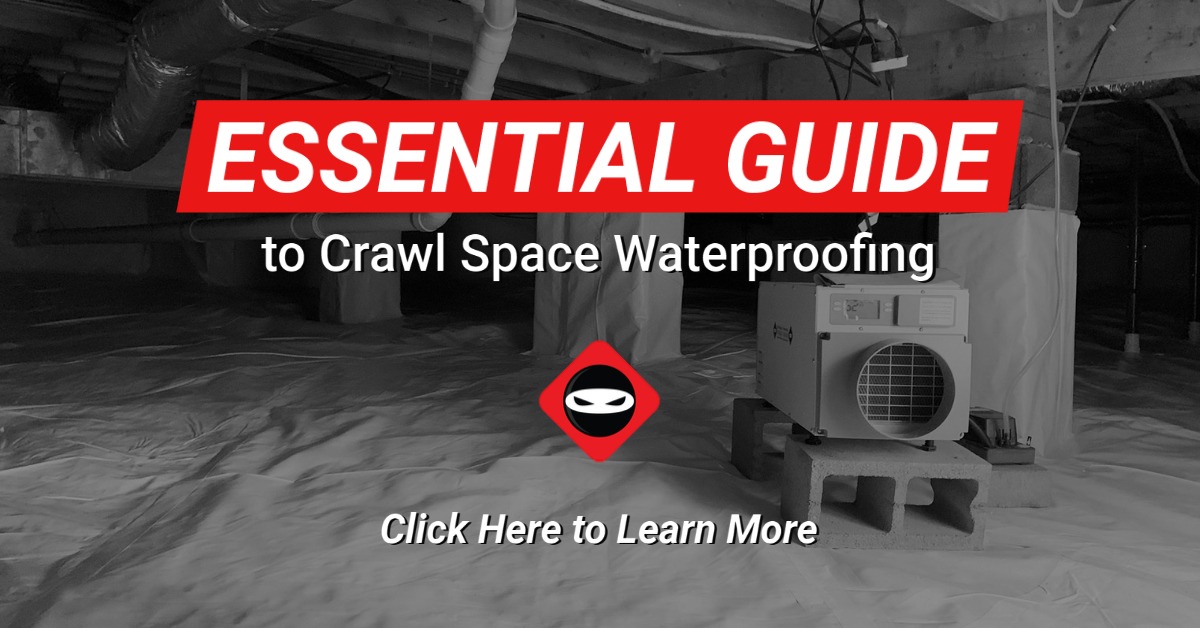Do you need crawl space french drain installation tips because your crawl space floods after heavy rains or there is a body of water close to your home? What I will be sharing today are guidelines for properly installing a waterproofing system in your crawl space.
Install the Drain Pipe Around the Entire Crawl Space
If you are taking on water in your crawl space, there is a possibility the entire foundation wall is wet whether you see it or not. Many homeowners and contractors only install the drainage system in the are they see standing water.
Avoid Future Drainage Problems
We recommend a full perimeter trench system in the crawl space to take care of the problem now and any potential future problems. No one wants to reinstall the vapor barrier 5 years later after a gutter floods and creates a pathway for flood water to enter your crawl space.
Pro Tip – In some cases you may need to install a french drain in the center of the crawl space and attach it to the perimeter. This is effective in areas close to big bodies of water like on the coast or near lakes. The water table in the soil is always high and can enter the center of the crawl space and float the vapor barrier.
Sump Pumps and Battery Back-ups
We do not usually use gravity to run the water out of the crawl space once it enters the french drain system. For us, using sump pumps attached to battery backup systems is a more reliable, long-term approach. Over time we have seen landscaping companies and homeowners forget where gravity discharge lines are and sometimes destroy them. Running a 1.5-inch PVC discharge to a pop-up emitter is less difficult to forget because it is always visible.
Of course, the time you will lose power is when you need it the most, during heavy flooding. The SEC 822PS Pump Sentry is great for pumps up to 1/2HP and the 1622PS covers up to 3/4HP. Both are great add-on battery backup systems to ensure your sump pump runs when it is needed the most. The Pump Sentry can be installed on new and existing systems in both crawl space and basement waterproofing applications.
Improve Your Sump Pump Water Discharge
Pro Tip – Make sure you are installing your sump pump into a sump pump basin with weep holes to allow moisture to enter. You can even dead-end the pipe into the basin to make sure water enters and is discharged faster.
Install the French Drain Near the Surface
We see articles and DIY guides advising homeowners to bury the french drain pipe at the footer in crawl spaces like you would in a finished basement, but keep in mind the main enemy is surface water. If you place the drainage system at the footer and you live in a hard soil or clay environment, the vapor barrier may float, or worse the water gets on top of the plastic before it has a chance to seep into the footer drain.
In crawl spaces, our primary concern is groundwater which can come from the footer, the foundation wall, or the door. Making sure the flood water has easy access to the drain tile you placed in the crawl space will ensure it discharges quicker to the outside.
Pro Tip – Make sure you weigh down the pipe if it is covered with a Styrofoam aggregate otherwise it can float out of your trench. Don’t use loose polystyrene foam poured into the trench because it will float out under your vapor barrier.
Ready to find out more?
Drop us a line today for a quote!
Click HereInstall a Properly Sealed and Attached Vapor Barrier
My final tip and probably the most overlooked is to actually encapsulate the crawl space by overlapping and sealing the plastic while mechanically attaching it to walls and pillars. Loose laid vapor barriers will shift at the first heavy flood so make sure your crawls pace plastic is secure to force the flood waters into the french drainage system.
Pro Tip – Using a solid crawl space vapor barrier is the best way to ensure no cat urine odor in the future. Water entering reinforced dual layer vapor barriers may give off ammonia odors similar to cat pee once the water gets trapped between the multiple layers and cannot escape.
Contact Crawl Space Ninja for Foundation Waterproofing and Encapsulation
Please contact us to schedule your assessment to fix your crawl space, basement or yard drainage issue.
Do you need help with mold removal, crawl space encapsulation, crawl space insulation, vapor barrier, waterproofing, foundation repair, basement waterproofing, or controlling humidity in your crawl space?
If you live in Georgia, Delaware, North Carolina, South Carolina, Tennessee, Ohio, or Kentucky, Crawl Space Ninja can help!
Also, let us know in the comments below if you have an idea for a new blog topic.
DIY Crawl Space Repair
Perhaps you’d like to tackle your own crawl space repair. Visit our DIY Store.
Join Crawl Space Ninja as an Owner
Learn about Crawl Space Ninja Franchise opportunities.





5 thoughts on “Installing Crawl Space French Drain Tips”
This is such an important topic in Wilmington, NC. Homeowners need solutions for moving water out of their active soil zone! Thank you Crawl Space Ninja Team!
Hey Michael, I’ve watched numerous videos of yours. I have encapsulated the Crawlspace in our old home but now I’m in the process of doing it in new construction on our new home. I’m doing a rough-in for the wall insulation using fur strips and the insulbarrier. This will be done before the subfloor is constructed! My question is in regards to the perimeter drain that I’m putting right on top of footer. The footer concrete was carried up very closely to grade on clay soil. A 4” pipe would lay partially above grade. I don’t plan to add a bunch of backfill in the whole Crawlspace floor. Our builder just wants to lay the pipe on the footer and not add any aggregate. Would you recommend adding backfill to level off the entire floor after the pipe is installed or would you just recommend adding washed stone over the pipe and gently grade it down to the existing crawl space floor?
Hi Jason, I like the pipe to be buried with the top of the pipe flush with the top of the dirt floor if possible but it doesn’t sound like you have that option here. I also like the pipe to be weighted with backfill to keep it in place. We have seen pipe buried with no backfill float out and move so yes, I would cover with stone as you mentioned to prevent this from happening. Hope that helps.
Great tips for installing a French drain in the crawl space! Ensuring a full perimeter trench system is crucial for effective water management, preventing future issues. The advice to include a French drain in the center for areas with high water tables is spot-on. Emphasizing the use of sump pumps with battery backups ensures reliability during heavy flooding. Keeping the drain near the surface and properly securing the pipe with Styrofoam aggregate helps prevent floatation issues. Excellent guide!
Thank you for sharing. We like sump pumps that can push high volumes of water and of course the Hydraway cavity drainage system moves water 70% faster than traditional french drain and perforated pipes.